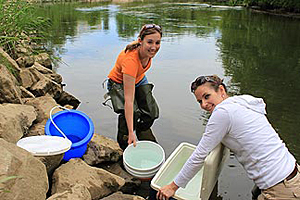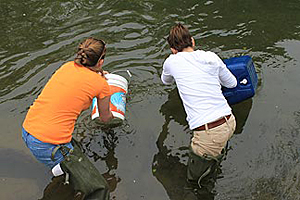
ADVERTISEMENT
- Rozovsky wins prestigious NSF Early Career Award
- UD students meet alumni, experience 'closing bell' at NYSE
- Newark Police seek assistance in identifying suspects in robbery
- Rivlin says bipartisan budget action, stronger budget rules key to reversing debt
- Stink bugs shouldn't pose problem until late summer
- Gao to honor Placido Domingo in Washington performance
- Adopt-A-Highway project keeps Lewes road clean
- WVUD's Radiothon fundraiser runs April 1-10
- W.D. Snodgrass Symposium to honor Pulitzer winner
- New guide helps cancer patients manage symptoms
- UD in the News, March 25, 2011
- For the Record, March 25, 2011
- Public opinion expert discusses world views of U.S. in Global Agenda series
- Congressional delegation, dean laud Center for Community Research and Service program
- Center for Political Communication sets symposium on politics, entertainment
- Students work to raise funds, awareness of domestic violence
- Equestrian team wins regional championship in Western riding
- Markell, Harker stress importance of agriculture to Delaware's economy
- Carol A. Ammon MBA Case Competition winners announced
- Prof presents blood-clotting studies at Gordon Research Conference
- Sexual Assault Awareness Month events, programs announced
- Stay connected with Sea Grant, CEOE e-newsletter
- A message to UD regarding the tragedy in Japan
- More News >>
- March 31-May 14: REP stages Neil Simon's 'The Good Doctor'
- April 2: Newark plans annual 'wine and dine'
- April 5: Expert perspective on U.S. health care
- April 5: Comedian Ace Guillen to visit Scrounge
- April 6, May 4: School of Nursing sponsors research lecture series
- April 6-May 4: Confucius Institute presents Chinese Film Series on Wednesdays
- April 6: IPCC's Pachauri to discuss sustainable development in DENIN Dialogue Series
- April 7: 'WVUDstock' radiothon concert announced
- April 8: English Language Institute presents 'Arts in Translation'
- April 9: Green and Healthy Living Expo planned at The Bob
- April 9: Center for Political Communication to host Onion editor
- April 10: Alumni Easter Egg-stravaganza planned
- April 11: CDS session to focus on visual assistive technologies
- April 12: T.J. Stiles to speak at UDLA annual dinner
- April 15, 16: Annual UD push lawnmower tune-up scheduled
- April 15, 16: Master Players series presents iMusic 4, China Magpie
- April 15, 16: Delaware Symphony, UD chorus to perform Mahler work
- April 18: Former NFL Coach Bill Cowher featured in UD Speaks
- April 21-24: Sesame Street Live brings Elmo and friends to The Bob
- April 30: Save the date for Ag Day 2011 at UD
- April 30: Symposium to consider 'Frontiers at the Chemistry-Biology Interface'
- April 30-May 1: Relay for Life set at Delaware Field House
- May 4: Delaware Membrane Protein Symposium announced
- May 5: Northwestern University's Leon Keer to deliver Kerr lecture
- May 7: Women's volleyball team to host second annual Spring Fling
- Through May 3: SPPA announces speakers for 10th annual lecture series
- Through May 4: Global Agenda sees U.S. through others' eyes; World Bank president to speak
- Through May 4: 'Research on Race, Ethnicity, Culture' topic of series
- Through May 9: Black American Studies announces lecture series
- Through May 11: 'Challenges in Jewish Culture' lecture series announced
- Through May 11: Area Studies research featured in speaker series
- Through June 5: 'Andy Warhol: Behind the Camera' on view in Old College Gallery
- Through July 15: 'Bodyscapes' on view at Mechanical Hall Gallery
- More What's Happening >>
- UD calendar >>
- Middle States evaluation team on campus April 5
- Phipps named HR Liaison of the Quarter
- Senior wins iPad for participating in assessment study
- April 19: Procurement Services schedules information sessions
- UD Bookstore announces spring break hours
- HealthyU Wellness Program encourages employees to 'Step into Spring'
- April 8-29: Faculty roundtable series considers student engagement
- GRE is changing; learn more at April 15 info session
- April 30: UD Evening with Blue Rocks set for employees
- Morris Library to be open 24/7 during final exams
- More Campus FYI >>
10:22 a.m., July 8, 2010----On May 7, the Water Resources Agency (WRA), a unit of the University of Delaware's Institute for Public Administration (IPA), released several hundred American shad fry into the White Clay Creek as part of the inaugural Shad in Schools project in the White Clay Creek watershed .
IPA assistant policy scientist Martha Corrozi Narvaez is the principal investigator and is working with IPA associate policy scientist Andrew Homsey, WRA director Jerry Kauffman, and urban and regional planning master's degree students Erin McVey, Sarah Chatterson and Stacy Mack to implement this program.
On May 2, migrating American shad were collected from the Potomac River and stripped of eggs by a project partner, the Interstate Commission on the Potomac River Basin.
WRA received these shad roe (eggs) and acclimated them to a tank of water. The shad roe hatched in approximately 2-3 days, and the fry were released in the tidal portion of the White Clay Creek at the Hale-Byrnes House, located on old Route 7 just south of Stanton, Del.
This release was part of a broader effort to restore American shad to the Delaware River Basin. On the same day, the Brandywine Conservancy coordinated a similar effort on the Brandywine River, which included four schools, two in Chadds Ford, Pa., and two in Wilmington, Del.
The program has a distinct timeline that must be followed each year in order to mimic the natural conditions in the stream and prepare for the arrival of the American shad eggs.
In mid-April WRA received the shad-rearing tank equipment, and the shad tank was constructed. The tank ran for approximately 2-3 weeks prior to receiving the shad eggs. During this time, WRA conducted water-quality tests on the system, including tests on ammonia, nitrite, nitrate, pH and temperature.
Shad are anadromous fish, spawning in fresh water streams and migrating to the ocean to grow and mature. The shad fry that were released will remain in the White Clay Creek until the water temperatures begin to drop in the fall. The shad will then swim out to the Atlantic Ocean, where they will continue to grow. They will remain in the ocean for 4-6 years before returning to the river they were released in for their first spawn.
The Shad in Schools program is an applied experience that educates students, teachers, and the public about the history, problems/decline, and life cycle of American shad while teaching math and science concepts through the balance of water conditions and temperature. The objectives of this program include:
- Educate and inform students, teachers, and the public about American shad and their significance;
- Assist in improving American shad populations in the Delaware River Basin; and
- Teach students about the importance of good water quality and habitat through hands-on testing and observations that utilize and teach science and math skills.
The Shad in Schools program, an education and outreach tool, is part of a larger effort, funded by the National Fish and Wildlife Foundation (NFWF) to restore shad and migratory fish passage and habitat, increase spawning areas, and benefit the resident fish in watersheds. (See related UDaily article.) The Delaware Shad Fishermen's Association and the Brandywine Conservancy are providing direction and assistance to WRA.
Through these efforts, WRA is gaining knowledge about the Shad in Schools program so that it can be replicated in schools in the White Clay Creek watershed next spring.
Historically, there have been declines in the abundance of American shad due to over-fishing, degradation of riverine habitat quality, dam construction, and pollution. Water quality, however, has improved in the past couple decades as a result of the Clean Water Act.
It is WRA's hope that the fish-passage barriers will be removed and the 107-square-mile National Wild and Scenic White Clay Creek watershed will become a sustainable habitat for the American shad.
Those who are interested in helping to restore American shad to the White Clay Creek and would like to bring this program to a school in the White Clay Creek watershed should contact Martha Corrozi Narvaez via email at [mcorrozi@udel.edu].
Article by Martha Corrozi Narvaez
Photos by Mark Deshon



